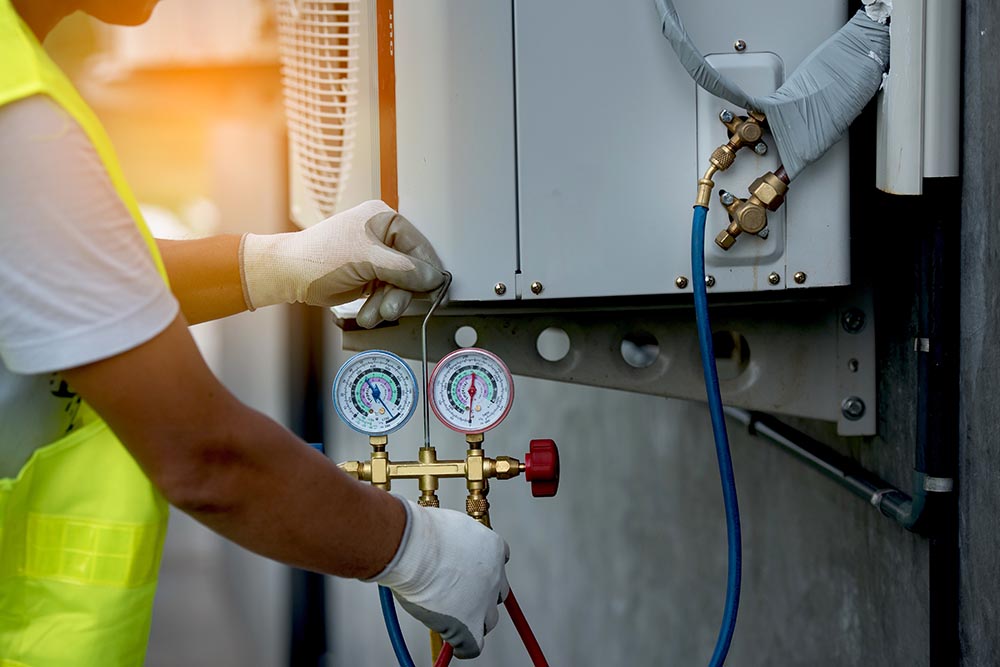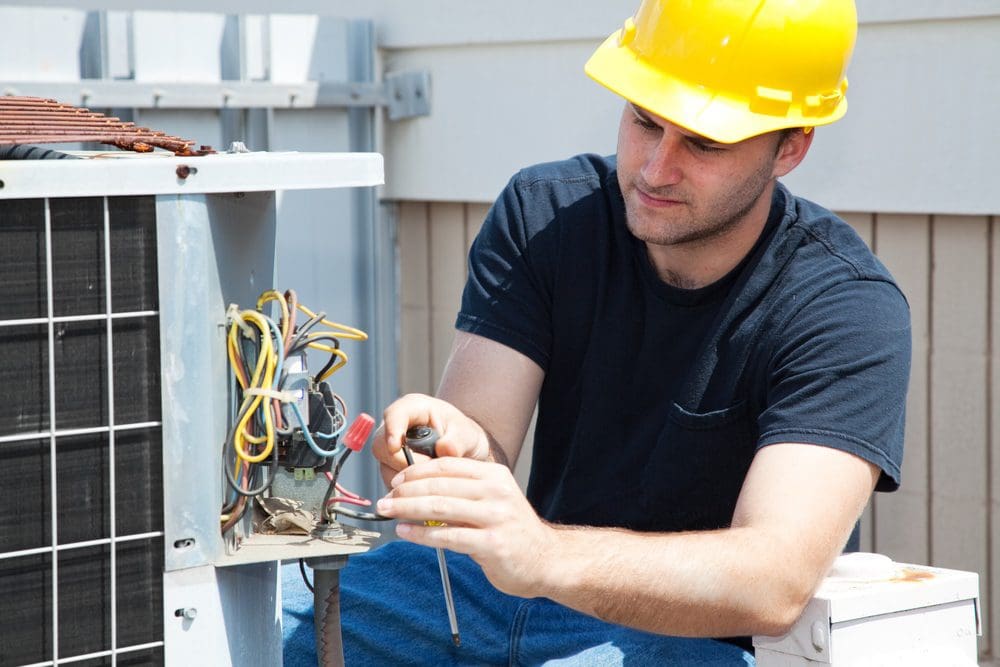How a Heatpump and Heating System Interact to Optimize Your Home's Home heating Performance
Understanding how a heatpump and heating system interact is important for property owners seeking effective heating solutions. Each system has its strengths, providing a balanced technique to home convenience. The heatpump stands out in modest temperatures, while the furnace supplies rapid warmth during severe cold. This harmony not only reduces power expenses but also enhances the life-span of both appliances. What elements influence this cooperation, and just how can home owners optimize their advantages?
Recognizing Warm Pumps: How They Function
Although lots of people may be strange with their internal functions, warm pumps play a necessary function in modern heating systems. These devices run by moving warm from one location to an additional, using the concepts of thermodynamics. In colder months, a heatpump extracts warm from the outside air, ground, or water, and transfers it indoors to warm up the home. On the other hand, during warmer months, it can turn around the process, working as an a/c unit by expelling warmth from inside to the outside.Heat pumps are composed of an evaporator, condenser, expansion, and compressor valve. The refrigerant within the system soaks up warm as it evaporates at low temperatures and pressures. The compressor after that boosts the stress and temperature of the refrigerant, enabling it to launch warmth as it condenses. This reliable process can greatly lower power consumption contrasted to conventional home heating methods, making warm pumps a sustainable selection for environment control in homes.
The Duty of Furnaces in Home Heating
Furnaces play a crucial function in home heating by supplying a dependable source of heat throughout the chillier months. They run by creating warmth via combustion or electric resistance, dispersing it throughout the home by means of air ducts or glowing systems. The performance of a heater is typically determined by its Yearly Fuel Utilization Performance (AFUE) rating, which indicates how successfully the system transforms gas right into heat.Furnaces can make use of different energy resources, consisting of all-natural gas, oil, lp, or electrical power, permitting homeowners to choose one of the most appropriate option for their requirements. Unlike warm pumps, which may battle in extreme cool, heaters preserve regular efficiency, ensuring that interior temperatures remain comfy despite outside conditions. In addition, modern heaters typically come geared up with innovative technology, such as variable-speed blowers and clever thermostats, boosting their efficiency and responsiveness. This flexibility makes heaters a vital component in all-inclusive home heating approaches.

Advantages of Making Use Of Both Solutions Together
Combining the strengths of both furnaces and heat pumps can cause a much more effective and effective home heating solution. Using both systems permits property owners to make the most of the heatpump's energy efficiency throughout milder temperature levels while relying upon the furnace for more severe cold conditions. This double technique can substantially decrease power prices, as warm pumps consume much less electrical power than typical heating methods when temperatures are moderate.Additionally, making use of both systems together can boost comfort degrees in the home. Heatpump can give constant, also heating, while heaters can rapidly increase ambient temperatures when needed. Moreover, the assimilation of both systems can extend the lifespan of devices by lowering wear and tear on each unit, as they share the workload. Inevitably, homeowners can appreciate a well balanced, cost-efficient home heating solution that adjusts seamlessly to varying climate condition, making certain a cozy and welcoming home throughout the cold weather.
Just How Warmth Pumps and Furnaces Complement Each Various Other
They create a complementary home heating system that makes best use of effectiveness and convenience when house owners integrate warmth pumps and heaters. Warmth pumps run by transferring warmth from the outside air or ground, making them highly efficient in modest environments. They stand out during milder temperature levels, offering affordable heating. Alternatively, heating systems produce warm through burning or electric resistance, delivering solid, instant heat throughout severe cold conditions.The combination of these two systems enables for vibrant modifications based on temperature variations. During warmer months or milder winter days, the heatpump can take the lead, conserving energy and reducing expenses. As temperatures decline, the heating system can flawlessly involve, making sure regular warmth throughout the home. This harmony not just enhances power usage but likewise enhances the life expectancy of both systems, as each unit operates within its optimal efficiency variety. With each other, they develop a balanced setting that adapts to article varying climate demands.
Maximizing Efficiency: Tips for Homeowners
Homeowners can boost their heating efficiency with several functional approaches. Developing a routine upkeep timetable, incorporating smart thermostat innovation, and implementing effective insulation and sealing options are key steps. These steps not only improve convenience but additionally decrease energy costs.
Normal Maintenance Arrange
To ensure optimal home heating performance, developing a routine upkeep routine is essential for any home. House owners need to focus on regular assessments of both heat pumps and heating systems to establish peak performance. This consists of changing air filters each to 3 months, as blocked filters can greatly decrease performance. In addition, scheduling specialist maintenance at the very least annually allows professionals to identify and attend to prospective problems before they rise. Property owners should likewise clean the heatpump's exterior unit to avoid particles accumulation that can hinder airflow. By adhering to a routine maintenance schedule, homeowners not just boost their heater' performance but also extend their lifespan, leading to higher convenience and reduced energy costs throughout the cooler months.
Smart Thermostat Integration
Integrating a clever thermostat right into a home heater can significantly improve energy effectiveness, specifically as it permits accurate control over temperature setups. These tools can learn the house owner's timetable and choices, instantly adjusting the temperature level to optimize comfort while reducing energy usage. They can decrease heating throughout times when the home is empty, lowering unneeded consumption. Numerous clever thermostats additionally supply real-time energy use information, allowing property owners to make informed choices regarding their heating routines. Additionally, remote accessibility through mobile phone applications permits users to readjust setups from anywhere, ensuring the home is cozy upon return. Overall, wise thermostat integration not only improves convenience yet substantially adds to power savings and effectiveness.
Insulation and Sealing Solutions
Smart thermostats play an important function in energy efficiency, yet their performance can be substantially improved by correct insulation and securing solutions. Property owners must focus on shielding attic rooms, floors, and wall surfaces to lessen heat loss. Top quality insulation products, such as spray foam or fiberglass, can greatly improve thermal resistance. In addition, sealing gaps around air ducts, doors, and home windows prevents cool air infiltration and warm retreat. Weatherstripping and caulking are effective methods for attending to these leaks - heat pump service. Normal examinations for air leaks, along with the use of blower door examinations, can assist determine trouble areas. By buying insulation and sealing, property owners can maximize the performance of their heating unit, ultimately leading to decreased power consumption and lower energy expenses
Typical Misconceptions Regarding Warm Pumps and Furnaces
What false impressions surround heatpump YOURURL.com and furnaces? Lots of individuals mistakenly believe that heat pumps are inadequate in colder environments. In truth, modern-day heat pumps are developed to run successfully also in reduced temperature levels, supplying reputable home heating throughout wintertime. Another usual myth is that heating systems are constantly much more reliable than heatpump. This depends on the certain energy resources and effectiveness ratings of the units in inquiry. Some may also assume that utilizing both systems concurrently is unnecessary, yet as a matter of fact, this combination can enhance heating efficiency, especially during extreme weather. Additionally, people typically assume that warmth pumps require continuous upkeep, when in reality, they have comparable upkeep needs to conventional heating unit. By exposing these myths, home owners can make more educated choices concerning their home heating options, inevitably bring about enhanced comfort and power efficiency in their homes.
Maintenance Considerations for Combined Solutions

Regularly Asked Concerns
Can Heat Pumps Work Properly in Incredibly Cold Climates?
Heatpump can battle in extremely cool environments due to decreased effectiveness and heat removal restrictions. Nevertheless, improvements in innovation have actually caused versions created for much better efficiency in such problems, improving their practicality in harsh settings.
How Much Time Do Heat Pumps and Furnaces Normally Last?
Heat pumps typically last 15 to two decades, while heating systems have a lifespan of 15 to three decades. Regular maintenance can extend their long life, guaranteeing reliable operation and lowering the requirement for early replacements.

What Is the Typical Price of Installing Both Solutions?
The average expense of installing both a heatpump and a heating system generally varies between $5,000 to $10,000 - heat pump replacement ooltewah tn. Aspects influencing this expense consist of system size, installment complexity, and regional labor rates
Are There Tax Motivations for Using Energy-Efficient Home Heating Solutions?
Many home owners inquire regarding tax incentives for energy-efficient heating unit. great post to read Numerous federal and state programs typically offer credit histories or discounts, motivating the fostering of lasting technologies to lower energy usage and advertise ecological duty.
Exactly how Do I Select the Right Dimension Warmth Pump and Heater?
Choosing the appropriate size warmth pump and furnace includes determining the home's square footage, considering insulation high quality, and examining neighborhood environment. Consulting a professional can guarantee optimal system efficiency and energy effectiveness based upon details demands. heat pump installation ooltewah tn. Recognizing exactly how a warm pump and heating system work together is vital for home owners looking for effective heating solutions. In colder months, a warm pump extracts warmth from the outdoors air, ground, or water, and transfers it indoors to warm up the living area. When house owners integrate heat pumps and furnaces, they create a corresponding home heating system that makes the most of efficiency and convenience. Warm pumps operate by transferring heat from the outdoors air or ground, making them highly effective in moderate climates. Warm pumps can battle in very chilly climates due to lowered effectiveness and warmth removal limitations